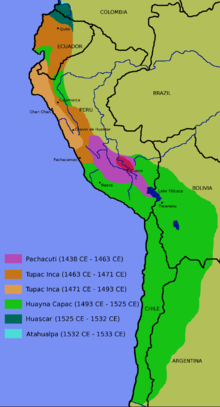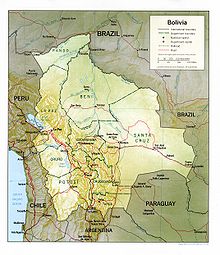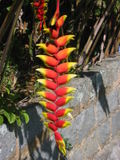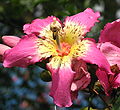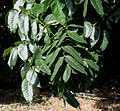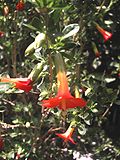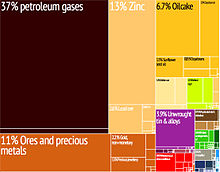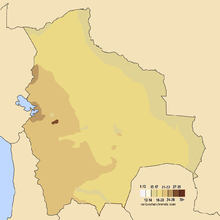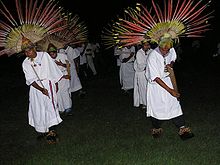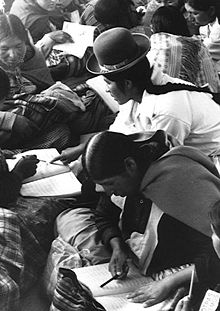
Bolivia
Did you know...
This content from Wikipedia has been selected by SOS Children for suitability in schools around the world. See http://www.soschildren.org/sponsor-a-child to find out about child sponsorship.
Coordinates: 16.712°S 64.666°W
Plurinational State of Bolivia
|
||||||
|---|---|---|---|---|---|---|
|
||||||
| Motto: "¡La unión es la fuerza!" (Spanish) "Unity is Strength!" |
||||||
| Anthem: Himno Nacional de Bolivia (Spanish) (also known as Bolivianos: el hado) |
||||||
Wiphala of Qollasuyu |
||||||
|
|
||||||
| Capital | Sucre (constitutional)a |
|||||
| Largest city | Santa Cruz de la Sierra 17°48′S 63°10′W |
|||||
| Official languages |
|
|||||
| Ethnic groups (2010) |
|
|||||
| Demonym | Bolivian | |||||
| Government | Unitary presidential constitutional republic | |||||
| - | President | Evo Morales | ||||
| - | Vice President | Álvaro García Linera | ||||
| Legislature | Plurinational Legislative Assembly | |||||
| - | Upper house | Senate | ||||
| - | Lower house | Chamber of Deputies | ||||
| Independence from Spain | ||||||
| - | Declared | 6 August 1825 | ||||
| - | Recognized | 21 July 1847 | ||||
| - | Current constitution | 7 February 2009 | ||||
| Area | ||||||
| - | Total | 1,098,581 km2 ( 28th) 424,163 sq mi |
||||
| - | Water (%) | 1.29 | ||||
| Population | ||||||
| - | 2012 census | |||||
| - | Density | 9/km2 ( 220th) 23/sq mi |
||||
| GDP ( PPP) | 2011 estimate | |||||
| - | Total | $50.904 billion | ||||
| - | Per capita | $4,789 | ||||
| GDP (nominal) | 2012 estimate | |||||
| - | Total | $27.800 billion | ||||
| - | Per capita | $2,314 | ||||
| Gini (2009) | 58.2 high |
|||||
| HDI (2011) | medium · 108th |
|||||
| Currency | Boliviano ( BOB) |
|||||
| Time zone | BOT ( UTC−4) | |||||
| Drives on the | right | |||||
| Calling code | +591 | |||||
| ISO 3166 code | BO | |||||
| Internet TLD | .bo | |||||
| a. | See below. | |||||
| b. | Quechua, Aymara and 34 other ethnic groups. | |||||
Bolivia ( / b ə ˈ l ɪ v i ə /, Spanish: [boˈliβja]), officially known as the Plurinational State of Bolivia (Spanish: Estado Plurinacional de Bolivia locally: [esˈtaðo pluɾinasjoˈnal de βoˈliβja], Quechua: Bulivya Mamallaqta, Aymara: Wuliwya Suyu), is a landlocked country located in central South America. It is bordered by Brazil to the north and east, Paraguay and Argentina to the south, Chile to the southwest, and Peru to the west.
Prior to European colonization, the Andean region of Bolivia was a part of the Inca Empire – the largest state in Pre-Columbian America. The conquistadors took control of the region in the 16th century. During most of the Spanish colonial period, this territory was known as Upper Peru and was under the administration of the Viceroyalty of Peru, which included most of Spain's South American colonies, although the area enjoyed substantial autonomy under the jurisdiction of the Royal Court of Charcas. After declaring independence in 1809, 16 years of war followed before the establishment of the Republic, named for Simón Bolívar, on 6 August 1825. Bolivia has struggled through periods of political instability and economic woes.
Bolivia is a democratic republic that is divided into nine departments. Its geography is varied from the peaks of the Andes in the West, to the Eastern Lowlands, situated within the Amazon Basin. It is a developing country, with a Medium Human Development Index score, and a poverty level of 53%. Its main economic activities include agriculture, forestry, fishing, mining, and manufacturing goods such as textiles, clothing, refined metals, and refined petroleum. Bolivia is very wealthy in minerals, especially tin. Bolivia has gained global attention for its ' Law of the Rights of Mother Earth', one of the unique laws in the world that accord nature the same rights as humans.
The Bolivian population, estimated at 10 million, is multiethnic, including Amerindians, Mestizos, Europeans, Asians and Africans. The main language spoken is Spanish, although the Guarani, Aymara and Quechua languages are also common and all three, as well as 34 other indigenous languages, are official. The large number of different cultures within Bolivia has contributed greatly to a wide diversity in fields such as art, cuisine, literature, and music.
Etymology
Bolivia was named after Simón Bolívar, a leader in the Spanish American wars of independence. Antonio José de Sucre had been given the option by Bolívar to either keep Upper Peru (present-day Bolivia) under the newly formed Republic of Peru, to unite with the United Provinces of Rio de la Plata, or to formally declare its independence from the Viceroyalty of Peru that had dominated most of the region. Sucre opted to create a new nation and, with local support, named it in honour of Simón Bolívar.
The original name given to the newly formed country was Republic of Bolívar. Some days later congressman Manuel Martín Cruz proposed: "If from Romulus comes Rome, then from Bolívar comes Bolivia" (Spanish: Si de Rómulo Roma, de Bolívar Bolivia). The name stuck and was approved by the Republic on 3 October 1825.
In 2009, a new constitution changed the country's name from the "Republic of Bolivia" to the "Plurinational State of Bolivia" in recognition of the multi-ethnic nature of the country and the enhanced position of Bolivia's indigenous peoples under the new constitution.
History
The region now known as Bolivia had been occupied for over 2,000 years when the Aymara arrived in the region. Present-day Aymara associate themselves with an advanced civilization situated at Tiwanaku, in Western Bolivia. The capital city of Tiwanaku dates from as early as 1500 BC when it was a small agriculturally based village.
The community grew to urban proportions between AD 600 and AD 800, becoming an important regional power in the southern Andes. According to early estimates the city covered approximately 6.5 square kilometers at its maximum extent, and had between 15,000 – 30,000 inhabitants. In 1996 satellite imaging was used to map the extent of fossilized suka kollus (flooded raised fields) across the three primary valleys of Tiwanaku, arriving at population-carrying capacity estimates of anywhere between 285,000 and 1,482,000 people.
Around AD 400, Tiwanaku went from being a locally dominant force to a predatory state. Tiwanaku expanded its reaches into the Yungas and brought its culture and way of life to many other cultures in Peru, Bolivia, and Chile. Tiwanaku was not a violent culture in many respects. In order to expand its reach, Tiwanaku exercised great political astuteness, creating colonies, fostering trade agreements (which made the other cultures rather dependent), and instituting state cults.
The empire continued to grow with no end in sight. William H. Isbell states that "Tiahuanaco underwent a dramatic transformation between AD 600 and 700 that established new monumental standards for civic architecture and greatly increased the resident population." Tiwanaku continued to absorb cultures rather than eradicate them. Archaeologists note a dramatic adoption of Tiwanaku ceramics into the cultures which became part of the Tiwanaku empire. Tiwanaku's power was further solidified through the trade it implemented among the cities within its empire.
Tiwanaku's elites gained their status through the surplus food they controlled, collected from outlying regions and then redistributed to the general populace. Further, this elite's control of llama herds became a powerful control mechanism as llamas were essential for carrying goods between the civic centre and the periphery. These herds also came to symbolize class distinctions between the commoners and the elites. Through this control and manipulation of surplus resources, the elite's power continued to grow until about AD 950. At this time a dramatic shift in climate occurred, causing a significant drop in precipitation in the Titicaca Basin, believed by archaeologists to have been on the scale of a major drought.
As the rainfall decreased, many of the cities further away from Lake Titicaca began to tender less foodstuffs to the elites. As the surplus of food decreased, and thus the amount available to underpin their power, the control of the elites began to falter. The capital city became the last place viable for food production due to the resiliency of the raised field method of agriculture. Tiwanaku disappeared around AD 1000 because food production, the main source of the power elite's control, dried up. The area remained uninhabited for centuries thereafter.
Between 1438 and 1527, the Inca empire, during its last great expansion, gained control over much of what is now western Bolivia. The Incas would not maintain control of the region for long, as the rapidly expanding Inca Empire was internally weak.
Colonial period
The Spanish conquest of the Inca empire began in 1524, and was mostly completed by 1533. The territory now called Bolivia was known as "Upper Peru", and was under the authority of the Viceroy of Lima. Local government came from the Audiencia de Charcas located in Chuquisaca (La Plata—modern Sucre). Founded in 1545 as a mining town, Potosí soon produced fabulous wealth, becoming the largest city in the New World with a population exceeding 150,000 people.
By the late 16th century Bolivian silver was an important source of revenue for the Spanish Empire. A steady stream of natives served as labor force under the brutal, slave conditions of the Spanish version of the pre-Columbian draft system called the mita. Upper Peru was bounded to Viceroyalty of the Río de la Plata in 1776. Túpac Katari led the indigenous rebellion that laid siege to La Paz in March 1781, during which 20,000 people died. As Spanish royal authority weakened during the Napoleonic wars, sentiment against colonial rule grew.
Independence and subsequent wars
The struggle for independence started in the city of Sucre the 25 May 1809, with the first cry of Freedom in Latin America. Chuquisaca Revolution (Chuquisaca was then the name of the city). That revolution, which created a local government Junta, was followed by the La Paz revolution, during which Bolivia actually declared independence. Both revolutions were short-lived, and defeated by the Spanish authorities, but the following year the Spanish American wars of independence raged across the continent. Bolivia was captured and recaptured many times during the war by the royalists and patriots. Buenos Aires sent three military campaigns, all of which were defeated, and eventually limited itself to protecting the national borders at Salta. Bolivia was finally freed of Royalist dominion by Antonio José de Sucre, with a military campaign coming from the North in support of the campaign of Simón Bolívar. After 16 years of war the Republic was proclaimed on 6 August 1825.
In 1836, Bolivia, under the rule of Marshal Andrés de Santa Cruz, invaded Peru to reinstall the deposed president, General Luis José de Orbegoso. Peru and Bolivia formed the Peru-Bolivian Confederation, with de Santa Cruz as the Supreme Protector. Following tension between the Confederation and Chile, Chile declared war on 28 December 1836. Argentina, Chile's ally, declared war on the Confederation on 9 May 1837. The Peruvian-Bolivian forces achieved several major victories during the War of the Confederation: the defeat of the Argentine expedition and the defeat of the first Chilean expedition on the fields of Paucarpata near the city of Arequipa.
On the same field, the Chilean and Peruvian rebel army surrendered unconditionally and signed the Paucarpata Treaty. The treaty stipulated that Chile would withdraw from Peru-Bolivia, Chile would return captured Confederate ships, economic relations would be normalized, and the Confederation would pay Peruvian debt to Chile. In Chile, public outrage over the treaty forced the government to reject it. Chile organized a second attack on the Confederation and defeated it in the Battle of Yungay. After this defeat, Santa Cruz resigned and went to exile in Ecuador and then Paris, and the Peruvian-Bolivian Confederation was dissolved.
Following the independence of Peru, Peruvian president General Agustín Gamarra invaded Bolivia. The Peruvian army was decisively defeated at the Battle of Ingavi on 20 November 1841 where Gamarra was killed. The Bolivian army under General José Ballivián then mounted a counter-offensive, capturing the Peruvian port of Arica. Later, both sides signed a peace treaty in 1842, putting a final end to the war.
Economic instability and continued wars
A period of political and economic instability in the early-to-mid-19th century weakened Bolivia. Then in the War of the Pacific (1879–83) against Chile, it lost its access to the sea and the adjoining rich salitre ( saltpeter) fields, together with the port of Antofagasta.
Since independence, Bolivia has lost over half of its territory to neighboring countries in wars and as a consequence of internal strife. It also lost the state of Acre, in the Acre War; important because this region was known for its production of rubber. Peasants and the Bolivian army fought briefly but after a few victories, and facing the prospect of a total war against Brazil, it was forced to sign the Treaty of Petrópolis in 1903, in which Bolivia lost this rich territory. Popular myth has it that Bolivian president Mariano Melgarejo (1864–71) traded the land for what he called "a magnificent white horse" and Acre was subsequently flooded by Brazilians which ultimately led to confrontation and fear of war with Brazil.
In the late 19th century, an increase in the world price of gold brought Bolivia relative prosperity and political stability. During the early 20th century, tin replaced gold as the country's most important source of wealth. A succession of governments controlled by the economic and social elite followed laissez-faire capitalist policies through the first thirty years of the 20th century.
Living conditions of the native people, who constitute most of the population, remained deplorable. With work opportunities limited to primitive conditions in the mines and in large estates having nearly feudal status, they had no access to education, economic opportunity, and political participation. Bolivia's defeat by Paraguay in the Chaco War (1932–35), where Bolivia lost a great part of the Gran Chaco region in dispute, marked a turning-point.
Nationalist Revolutionary Movement
The Revolutionary Nationalist Movement (MNR), the most historic political party, emerged as a broad-based party. Denied its victory in the 1951 presidential elections, the MNR led a successful revolution in 1952. Under President Víctor Paz Estenssoro, the MNR, having strong popular pressure, introduced universal suffrage into his political platform and carried out a sweeping land-reform promoting rural education and nationalization of the country's largest tin mines.
12 years of tumultuous rule left the MNR divided. In 1964, a military junta overthrew President Estenssoro at the outset of his third term. The 1969 death of President René Barrientos Ortuño, a former member of the junta who was elected president in 1966, led to a succession of weak governments. Alarmed by the rising Popular Assembly and the increase in the popularity of President Juan José Torres, the military, the MNR, and others installed Colonel (later General) Hugo Banzer Suárez as president in 1971. H returned to the presidency in 1985–1989, 1993–1997, and 2002–2003.
CIA activities and leftist insurgency
The CIA had been active in providing finances and training to the Bolivian military in 1960s. The revolutionary leader Che Guevara was killed by a team of CIA officers and members of the Bolivian Army on 9 October 1967, in Bolivia. The CIA reported that Guevara was captured on 8 October as a result of the clash with the Cuban-led guerrillas. He had a wound in his leg, but was otherwise in fair condition. At 1150 hours on 9 October the Second Ranger Battalion received direct orders from Bolivian Army Headquarters in La Paz to kill Guevara. These orders were carried out at 1315 hours the same day with a burst of fire from an M-2 automatic rifle. Félix Rodríguez was a CIA officer on the team with the Bolivian Army that captured and shot Guevara. Rodriguez said that after he received a Bolivian presidential execution order, he told "the soldier who pulled the trigger to aim carefully, to remain consistent with the Bolivian government's story that Che had been killed in action during a clash with the Bolivian army." Rodriguez said the US government had wanted Che in Panama, and "I could have tried to falsify the command to the troops, and got Che to Panama as the US government said they had wanted", said Mr Rodriguez, but he chose to "let history run its course" as desired by Bolivia."
Military governments: García Meza and Siles Zuazo
Elections in 1979 and 1981 were inconclusive and marked by fraud. There were coups d'état, counter-coups, and caretaker governments. In 1980, General Luis García Meza Tejada carried out a ruthless and violent coup d'état that did not have popular support. He pacified the people by promising to remain in power only for one year. At the end of the year, he staged a televised rally to claim popular support and announced, "Bueno, me quedo", or, "All right; I'll stay [in office]." He was deposed shortly thereafter. His government was notorious for human rights abuses, drug-trafficking, and economic mismanagement; during his presidency, the inflation that later crippled the Bolivian economy could already be felt. Later convicted in absentia for various crimes by attorney Juan del Granado, including murder, García Meza was extradited from Brazil and began serving a 30-year prison sentence in 1995.
After a military rebellion forced out Meza in 1981, three other military governments in 14 months struggled with Bolivia's growing problems. Unrest forced the military to convoke the Congress elected in 1980 and allow it to choose a new chief executive. In October 1982, Hernán Siles Zuazo again became president, 22 years after the end of his first term of office (1956–60).
Sánchez de Lozada and Banzer: Liberalizing the economy
Gonzalo Sánchez de Lozada pursued an aggressive economic and social reform agenda. The most dramatic reform was the "capitalization" program, under which investors, typically foreign, acquired 50% ownership and management control of public enterprises, such as the state petroleum corporation, telecommunications system, airlines, railroads, and electric utilities, in return for agreed upon capital investments.
The reforms and economic restructuring were strongly opposed by certain segments of society, which instigated frequent and sometimes violent protests, particularly in La Paz and the Chapare coca-growing region, from 1994 through 1996. The de Lozada government pursued a policy of offering monetary compensation for voluntary eradication of illegal coca by its growers in the Chapare region. The policy produced little net reduction in coca, and in the mid-1990s Bolivia accounted for about one-third of the world's coca that was being processed into cocaine. The coca leaf has long been part of the Bolivian culture, as indigenous workers have traditionally used the leaf for its properties as a mild stimulant and appetite suppressant.
During this time, the umbrella labor-organization of Bolivia, the Central Obrera Boliviana (COB), became increasingly unable to effectively challenge government policy. A teachers' strike in 1995 was defeated because the COB could not marshal the support of many of its members, including construction and factory workers. The state also used selective martial law to keep the disruptions caused by the teachers to a minimum. The teachers were led by Trotskyites, and were considered to be the most militant union in the COB. Their downfall was a major blow to the COB, which also became mired in internal corruption and infighting in 1996.
In the 1997 elections, General Hugo Banzer, leader of the Nationalist Democratic Action party (ADN) and former dictator (1971–78), won 22% of the vote, while the MNR candidate won 18%. General Banzer formed a coalition of the ADN, MIR, UCS, and CONDEPA parties, which held a majority of seats in the Bolivian Congress. The Congress elected him as president, and he was inaugurated on 6 August 1997. During the election campaign, Banzer had promised to suspend the privatization of the state-owned oil-company, YPFB. But this seemed unlikely to happen, considering Bolivia's weak position globally. The Banzer government basically continued the free-market and privatization-policies of its predecessor.
The relatively robust economic growth of the mid-1990s continued until about the third year of its term in office. After that, regional, global and domestic factors contributed to a decline in economic growth. Financial crises in Argentina and Brazil, lower world prices for export commodities, and reduced employment in the coca sector depressed the Bolivian economy. The public also perceived a significant amount of public sector corruption. These factors contributed to increasing social protests during the second half of Banzer's term.
At the outset of his government, President Banzer launched a policy of using special police-units to physically eradicate the illegal coca of the Chapare region. The policy produced a sudden and dramatic four-year decline in Bolivia's illegal coca crop, to the point that Bolivia became a relatively small supplier of coca for cocaine. Those left unemployed by coca eradication streamed into the cities, especially El Alto, the slum-neighbourhood of La Paz. The MIR of Jaime Paz Zamora remained a coalition-partner throughout the Banzer government, supporting this policy (called the Dignity Plan).
Between January 1999 and April 2000, large-scale protests erupted in Cochabamba, Bolivia's third largest city, in response to the privatization of water resources by foreign companies and a subsequent doubling of water prices.
On 6 August 2001, Banzer resigned from office after being diagnosed with cancer. He died less than a year later. Vice President Jorge Fernando Quiroga Ramírez completed the final year of his term.
In the June 2002 national elections, former President Gonzalo Sánchez de Lozada (MNR) placed first with 22.5% of the vote, followed by coca-advocate and native peasant-leader Evo Morales ( Movement Toward Socialism, MAS) with 20.9%. Morales edged out populist candidate Manfred Reyes Villa of the New Republican Force (NFR) by just 700 votes nationwide, earning a spot in the congressional run-off against Sánchez de Lozada on 4 August 2002.
A July agreement between the MNR and the fourth-place MIR, which had again been led in the election by former President Jaime Paz Zamora, virtually ensured the election of Sánchez de Lozada in the congressional run-off, and on 6 August he was sworn in for the second time. The MNR platform featured three overarching objectives: economic reactivation (and job creation), anti- corruption, and social inclusion.

In 2003 the Bolivian gas conflict broke out. On 12 October 2003 the government imposed martial law in El Alto after 16 people were shot by the police and several dozen wounded in violent clashes which erupted when a caravan of oil trucks escorted by police and soldiers deploying tanks and heavy-caliber machine guns tried to breach a barricade. On 17 October 2003 Evo Morales' supporters from Cochabamba tried to march into Santa Cruz de la Sierra, the largest city of the eastern lowlands where support was strong for the president. They were turned back. Faced with the option of resigning or more bloodshed, Sanchez de Lozada offered his resignation in a letter to an emergency session of Congress. After his resignation was accepted and his vice president, Carlos Mesa, invested, he left on a commercially scheduled flight for the United States.
In March 2004, the new president Carlos Mesa announced that his government would hold a series of rallies around the country, and at its embassies abroad, demanding that Chile return to Bolivia a stretch of seacoast that the country lost in 1884 after the end of the War of the Pacific. Chile has traditionally refused to negotiate on the issue, but Mesa nonetheless made this policy a central point of his administration.
The country's internal situation became unfavorable for such political action on the international stage. After a resurgence of gas protests in 2005, Carlos Mesa attempted to resign in January 2005, but his offer was refused by Congress. On 22 March 2005, after weeks of new street protests from organizations accusing Mesa of bowing to U.S. corporate interests, Mesa again offered his resignation to Congress, which was accepted on 10 June. The chief justice of the Supreme Court, Eduardo Rodríguez, was sworn as interim president to succeed the outgoing Carlos Mesa.
Plan de Todos
Mobilizing against neoliberalism as an enemy of socialism, the indigenous population of the Andean region was able to achieve widespread government reform. Bolivia, in particular, was quite successful due to the prominence of an indigenous population and the persistence of reformist policies. In 1993, Gonzalo Sanchez de Lozada ran for president in alliance with the Tupac Katari Revolutionary Liberation Movement, which inspired indigenous-sensitive and multicultural-aware policies. Gonzalo Sanchez de Lozada (colloquially known as Goni) was able to shift Bolivian society by selling state firms and constitutionally acknowledging the existence of a multicultural and multiethnic population. Current development has led to a neoliberal citizenship regime in which civil rights are expressed through private property ownership, formal democracy and representation, and an investment in the maintaining of infrastructure.
In the 1990s, Bolivia introduced, the Plan de Todos, which led to the decentralization of government, introduction of intercultural bilingual education, implementation of agrarian legislation, and privatization of state owned businesses. The Plan de Todos main incentive was to encourage popular participation among the Bolivian people. The law recognizes the existence of barrios and rural communities as Territorially Based Organizations (TBOs) and has oversight boards known as rómiles de agilancia, or vigilance committees, that are responsible for overseeing municipal governments and planning projects. The Plan formally acknowledged the existence of 311 municipalities, which benefited directly based on the size of their populations. The Plan de Todos inspired the development of a market democracy with minimally regulated capitalist economy. The Plan explicitly stated that Bolivian citizens would own a minimum of 51% of enterprises; under the Plan, most state owned enterprises (SOEs), besides mines, were sold. This privatization of SOEs led to innovative neoliberal structuring that acknowledged a diverse population within Bolivia.
The Law of Popular Participation gave municipalities the responsibility of maintaining various infrastructures (and offering services): health, education, systems of irrigation, which stripped the responsibility away from the state. The state provides municipalities with 20% of federal tax revenue so that each municipality can adequately maintain these infrastructures. The Law also redistributes political power to the local level.
The Plurinational State of Bolivia
The main candidates for the 2005 Bolivian presidential election held on 18 December 2005 were Juan Evo Morales Ayma of the MAS Party and Jorge Quiroga, leader of the Social and Democratic Power (PODEMOS) Party and former head of the Acción Democrática Nacionalista (ADN) Party. Morales won the election with 53.7% of the votes, an absolute majority, unusual in Bolivian elections. He was sworn in on 22 January 2006, for a five-year term. Prior to his official inauguration in La Paz, he was inaugurated in an Aymara ritual at the archeological site of Tiwanaku before a crowd of thousands of Aymara people and representatives of leftist movements from across Latin America. Though highly symbolic, this ritual was not historically based and primarily represented native Aymaras — not the main Quechua-speaking population. Since the Spanish conquest in the early 16th century, this region of South America, with a majority native population, has been ruled mostly by descendants of European immigrants.
On 1 May 2006, Morales caused controversy when he announced his intent to re-nationalize Bolivian hydrocarbon assets. While stating that the initiative would not be an expropriation, Morales sent Bolivian troops to occupy 56 gas installations simultaneously, including the two Petrobras-owned refineries which provide over 90% of Bolivia's refining-capacity. All foreign energy firms were required to sign new contracts within 180 days, giving Bolivia majority ownership and up to 82% of revenues for the largest natural gas fields. All such firms signed new contracts. Reports from the Bolivian government and the companies involved are contradictory as to plans for future investment.
By far the biggest customer for Bolivian hydrocarbons has been Brazil, which imports two-thirds of Bolivia's natural gas via pipelines operated by the semi-private Petrobras. Since gas can only be exported from landlocked Bolivia via Petrobras' large (and expensive) pipelines, the supplier and customer are strongly linked. Petrobras has announced plans to produce enough natural gas by 2011 to replace that now supplied by Bolivia. Bolivia's position is strengthened by the knowledge that hydrocarbon reserves are more highly valued now than at the times of previous nationalizations, and by the pledged support of leftist President Hugo Chávez of Venezuela.
Fulfilling a campaign promise, on 6 August 2006, Morales opened the Bolivian Constituent Assembly to begin writing a new constitution aimed at giving more power to the indigenous majority. Problems immediately arose when, unable to garner the two-thirds majority needed to include controversial provisions in the constitutional draft, Morales' party announced that only a simple majority would be needed to draft individual articles while a two-thirds majority would be needed to pass the document in full. Violent protests arose in December 2006 in parts of the country for both two-thirds and departmental autonomy, mostly in the eastern third of the country, where much of the hydrocarbon wealth is located. MAS and its supporters believed the two-thirds voting requirement would give an effective veto for all constitutional changes to the conservative minority.
In August 2007, more conflicts arose in Sucre, as the city demanded the discussion of the seat of government inside the assembly, hoping the executive and legislative branches could return to the city, but the assembly and the government said this demand was overwhelmingly impractical and politically undesirable. The conflict turned into violence, and the assembly was moved to a military area in Oruro. Although the main opposition party boycotted the session, a constitutional draft was approved on 24 November.
In May 2008, Evo Morales was a signatory to the UNASUR Constitutive Treaty of the Union of South American Nations. Bolivia has ratified the treaty.
In the 2009 national general elections, Evo Morales was re-elected with 64.22% of the vote. His party, Movement for Socialism, also won a two-thirds majority in both houses of the National Congress.
Administrative divisions
Bolivia is divided into nine departments, further subdivided into 112 provinces and these ones into 339 municipalities and into native community lands.
According to what is established by the Bolivian Political Constitution, the Law of Autonomies and Decentralization regulates de procedure for the elaboration of Statutes of Autonomy, the transfer and distribution of direct competences between the central government and the autonomous entities. There are four levels of decentralization:
- Departmental government
- Constituted by the Departmental Assembly, with rights over the legislation of the department. The governor is chosen by universal suffrage.
- Municipal government
- Constituted by a Municipal Council, with rights over the legislation of the municipality. The mayor is chosen by universal suffrage.
- Regional government
- Conformed by several provinces or municipalities of geographical continuity within a department. It is constituted by a Regional Assembly.
- Original indigenous government
- Self-governance of original indigenous people on the ancient territories where they live.
| Territorial division of Bolivia | ||||||
| Department | Abbreviation ( ISO) |
Population | Surface (km²) | Density | Capital city | 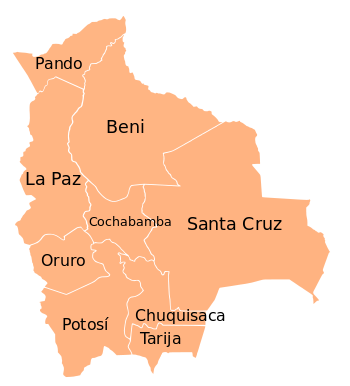 |
|---|---|---|---|---|---|---|
| BO | 10.027.644 | 1.098.581 | 9.1 | Sucre (Constitutional) | ||
| BO-B | 425.780 | 213.564 | 1.9 | Trinidad | ||
| BO-H | 631.062 | 51.524 | 11.9 | Sucre | ||
| BO-C | 1.938.401 | 55.631 | 22.7 | Cochabamba | ||
| BO-L | 2.741.554 | 133.985 | 19.9 | La Paz | ||
| BO-O | 444.093 | 53.558 | 8.2 | Oruro | ||
| BO-N | 109.173 | 63.827 | 1.1 | Cobija | ||
| BO-P | 780.392 | 118.218 | 6.5 | Potosí | ||
| BO-S | 2.776.244 | 370.621 | 7.1 | Santa Cruz de la Sierra | ||
| BO-T | 496.988 | 37.623 | 12.5 | Tarija | ||
| Source: Demographic Projections 2008, Bolivian National Demographic Institute. The departmental densitiy has been calculated with the population of 2006. | ||||||
Territorial borders
| Boundaries | |||
| Country | Terrestrial | Maritime | Total |
|---|---|---|---|
| 471 | 302 | 773 | |
| 750 | 2.673¹ | 3.423 | |
| 830 | 20 | 850 | |
| 634 | 57 | 741 | |
| 513 | 534² | 1.047 | |
| Terrestrial | 3.469 | ||
| Maritime | 3.579 | ||
| Total | 6.834 | ||
| Notes: 1 =From the 2.673 kilometers of maritime boundaries with Brazil, 95 kilometers are lakes, being the rest rivers. |
|||
Bolivia's borders on the north and east are with the Federative Republic of Brazil, on the east and southeast with the Republic of Paraguay, on the south with the Argentine Republic, on the southwest with the Republic of Chile and on the west with the Republic of Peru. The total perimeter of the boundaries is 6.834 kilometers.
- The border with Argentina: This international border starts at the Zapalari mountain and ends in Esmeralda, Tarija Department (which is a triple boundary point between Bolivia, Argentina and Paraguay). The main boundary points are the Panizo mountain, the Malpaso mountain, the towns of Villazón, Bermejo, Fortín Campero, Yacuiba and Fortín D'Orbigny over the Pilcomayo River.
- The border with Brazil: This international border is the most extensive. It starts in the town of Bolbepra and ends on Bahía Negra ("Black Bay"), which is a triple boundary between Brazil, Paraguay and Bolivia. The main boundary points are Brasiléia, located in front of Cobija), the towns of Fortín Manoa (close to the Madeira River), Villa Bella, Cerro Cuatro Hermanos, San Matías, the La Gaiba Lake, the Mandioré Lake, the Cáceres Lake and the Gutiérrez Guerra Port in the Paraguay River.
- The border with Chile: The current border between Bolivia and Chile was agreed with the Treaty of Peace and Friendship of 1904. This document allowed the surrender of the Bolivian littoral zone and coasts in the Pacific Ocean, making Bolivia a landlocked country. The border starts at Visviri (the boundary point for Bolivia, Chile and Peru) and ends at the Zapaleri mountain, which is a triple boundary point for Chile, Bolivia and Argentina. The main points of the boundary are the Licancabur and Ollagüe volcanos and the Payachata mountains.
- The border with Paraguay: It starts in Esmeralda and ends on Bahía Negra, on the Black River. The main boundary points are the Ustares mountain, Palmar de las Islas, Hito Chovoreca and the Jara mountain.
- The border with Peru: The boundary starts at the town of Bolbepra (the triple boundary point for Bolivia, Peru and Brazil) and ends on Choquecota and Visviri. The most important points in the international boundary are the Heath Port on the Madre de Dios River, the Apolobamba mountain range and Puerto Acosta, where the division of the Titicaca Lake starts.
Maritime claims and rights
Despite losing its maritime coast, the so-called Littoral Department, after the War of the Pacific, Bolivia has historically maintained, as a state policy, a maritime claim to Chile; the claim asks for sovereign access to the Pacific Ocean and its maritime space. The Political Constitution of 2009 established that Bolivia declares its right to access to the sea, and that its objective is to solve the problem peacefully.
Since the foundation of the United Nations in 1945, Bolivia has requested the General Assembly to consider its petition for sovereign access to the Pacific Ocean. The issue has also been presented before the Organization of American States; in 1979, the OAS passed the 426 Resolution, which declared that the Bolivian problem is a hemispheric problem. Chile has tried to assist in the matter, but without yielding any of its sovereign territory.
- Access to the Pacific Ocean by Chile. On 4 April 1884, a truce was signed with Chile, whereby Chile gave facilities of access to Bolivian products through Antofagasta, and freed the payment of export rights in the port of Arica. In October 1904, the Treaty of Peace and Friendship was signed, and Chile agreed to build a railway between Arica and La Paz, to improve access of Bolivian products to the ports.
- Access to the Pacific Ocean by Peru. The Special Economical Zone for Bolivia in Ilo (ZEEBI) is a special economic area of 5 km of maritime coast, and a total extension of 358 hectares, called Mar Bolivia ("Sea Bolivia"), where Bolivia may maintain a free port near Ilo, Peru under its administration and operation for a period of 99 years starting on 1992; once the time has passed, all the construction and territory go back to the Peruvian government.
- Access to the Atlantic Ocean by Argentina. Since 1964, Bolivia has had its own port facilities in the Bolivian Free Port in Rosario, Argentina. This port is located on the Paraná River, which is directly connected to the Atlantic Ocean.
Geography
Bolivia is located in the central zone of South America, between the meridians 57° 26´ and 69° 38´ longitude west of the Prime Meridian, and the parallels 9° 38´ and 22° 53´ of southern latitude. At 1,098,580 square kilometres (424,160 sq mi), Bolivia is the world's 28th-largest country. Its surface extends from the Central Andes, going partially through the Gran Chaco, as far as the Amazon. The geographic centre of the country is the so-called Puerto Estrella ("Star Port") on the Río Grande, in Ñuflo de Chávez Province, Santa Cruz Department.
The geographic location of the country comprises a great variety of terrains and climates. Bolivia has a huge degree of biodiversity, considered one of the greatest in the world; as well as several ecoregions with such ecological subunits as the Altiplano, tropical rainforests (including Amazon rainforest), dry valleys, and the Chiquitania, which is a tropical savanna. All of these feature enormous variations in altitude, from an elevation of 6,542 meters above sea level in Nevado Sajama, to nearly 70 meters along the Paraguay River. Despite this great geographic contrast, Bolivia has remained a landlocked country since the War of the Pacific.
Land relief
Bolivia can be divided into three physiographic regions:
- Andean Region: in the southwest; it spans 28% of the national territory, extending over 307,603 km². This area is located above 3000 meters altitude, and is located between two big Andean chains: the Cordillera Occidental ("western range") and the Cordillera Central ("central range"), with some of the highest spots in the Americas, such as the Nevado Sajama, with 6,542 meters, and the Illimani with 6,462 meters. Here also is located Lake Titicaca, the highest commercially navigable lake in the world, and also the largest lake in South America, shared with Peru. Also in this region are the Altiplano and the Salar de Uyuni, which is the largest salt flat of the world and an important source of lithium.
- Sub-Andean region: in the centre and south; an intermediate region between the Altiplano and the eastern llanos, it comprises 13% of the territory, extending over 142,815 km². It encompasses the Bolivian valleys and the Yungas region. It is distinguished by its farming activities and its temperate climate.
- Llanos region: in the northeast; it comprises 59% of the territory with 648,163 km². It is located to the north of the Cordillera Central; it extends from the Andean foothills to the Paraguay River. It is a region of flatland and small plateaus, all covered by extensive rainforests with enormous biodiversity. The region is located below 400 meters above sea level.
Hydrography
Bolivia has three drainage basins that flow into the Atlantic Ocean or the Pacific Ocean.
- Amazon Basin, also called the North Basin (724,000 km² / 66% of the territory). The rivers of this basin generally have big meanders, thereby forming lakes such as the Murillo Lake in Pando Department. The main Bolivian tributary to the Amazon basin is the Mamoré River, with a length of 2000 km running north to the confluence with the Beni River, 1,113 km of length and the second most important river of the country. The Beni River, along with the Madeira River, forms the main tributary of the Amazon River. From east to west, the basin is formed by other important rivers such as the Madre de Dios River, Orthon River, Abuna River, Yata River and the Guaporé River. The most important lakes are the Rogaguado Lake, the Rogagua Lake and the Jara Lake.
- Rio de la Plata Basin, also called the South Basin (229,500 km² / 21% of the territory). The tributaries are in general less abundant than the ones forming the Amazon basin. It is mainly formed by the Paraguay River, Pilcomayo River and Bermejo River. The most important lakes are the Uberaba Lake and the Mandioré Lake, both located in the Bolivian marshland.
- The Central Basin, which is an endorrheic basin (145,081 km² / 13% of the territory). The Altiplano has large numbers of lakes and rivers that do not run into any ocean, as they are enclosed by the Andean mountains. The most important river is the Desaguadero River, with a length of 436 km, the longest river of the Altiplano; it begins in Lake Titicaca and then runs in a southeast direction to the Poopó Lake. The basin is then formed by the Lake Titicaca, Lake Poopó, the Desaguadero River and great salt flats as the Salar de Uyuni and the Coipasa Lake.
| Main elevations, rivers and lakes of Bolivia | ||||||||
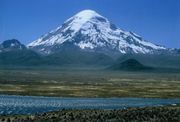 Nevado Sajama |
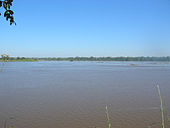 Mamoré River |
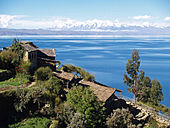 Lake Titicaca |
||||||
|---|---|---|---|---|---|---|---|---|
| Elevations | Rivers | Lakes | ||||||
| N° | Name | Elevation (m) |
N° | Name | Length (km) |
N° | Name | Surface (km²) |
| 1 | Sajama | 6,542 | 1 | Mamoré | 2,000 | 1 | Titicaca | 3,790¹ |
| 2 | Illampu | 6.485 | 2 | Itonomas River | 1.493 | 2 | Poopó | 2.337 |
| 3 | Illimani | 6,462 | 3 | Grande | 1,438 | 3 | Coipasa | 806 |
| 4 | Janq'u Uma | 6,427 | 4 | Beni | 1,130 | 4 | Rogoaguado | 329 |
| 5 | Parinacota | 6,362 | 5 | Blanco | 1,087 | 5 | Rogaguado | 315 |
| Notes: 1 = The Lake Titicaca has a total surface of 8,562 km², from which 3,790 km² are in Bolivia. |
||||||||
| Source: Bolivian National Geographic Institute (IGN) | ||||||||
Climate
The climate of Bolivia varies drastically from one ecoregion to the other, from the tropics in the eastern llanos to polar climates in the western Andes. The summers are warm, humid in the east and dry in the west, with rains that often modify temperatures, humidity, winds, atmospheric pressure and evaporation, giving place to very different climates. When the climatological phenomenon known as El Niño takes place, it provokes great alterations in the weather. Winters are very cold in the west, and it snows around the mountain ranges, while in the western regions, windy days are more usual. The autumn is dry in the non-tropical regions.
- Llanos. A humid tropical climate with an average temperature of 30°C. The wind coming from the Amazon rainforest causes significant rainfall. Starting in May, there is low precipitation because of dry winds, and most days have clear skies. Even so, winds from the south, called surazos, can bring cooler temperatures lasting several days.
- Altiplano. Desert- Polar climates, with strong and cold winds. The average temperature ranges from 15 to 20°C. At night, temperatures descend drastically to slightly above 0°C, while during the day, the weather is dry and solar radiation is high. Ground frosts occur every month, and snow is frequent.
- Valleys and Yungas. Temperate climate. The humid northeastern winds are pushed to the mountains, making this region very humid and rainy. Temperatures are cooler at higher elevations. Snow occurs at altitudes of 2000 meters.
- Chaco. Subtropical Semi-arid climate. Rain and humidity in January and the rest of the year, with warm days and cool nights.
| Bioclimatic landscapes of Bolivia | |||||||
 |
 |
 |
 |
||||
| Tropical rainforest Los Yungas, La Paz |
Cold desert Dalí Desert, Potosí |
Dry broadleaf forest Chaqueño Forest, Santa Cruz |
Template valley Samaipata, Santa Cruz |
||||
 |
 |
 |
 |
||||
| Rainforest Amazon rainforest, Cochabamba |
Humid Altiplano Collao Plateau, La Paz |
Dry Altiplano Isla del Pescado, Potosí |
Andean glacier Glaciar Lake, La Paz |
||||
Biodiversity
Bolivia is part of the " Like-Minded Megadiverse Countries", and has an enormous variety of organisms and ecosystems.
Bolivia's variable altitudes, ranging from 90 to 6,542 meters above sea level, allow for a vast biologic diversity. The territory of Bolivia comprises 4 types of biomes, 32 ecological regions, and 199 ecosystems. Within this geographic area there are several natural parks and reserves, such as the Noel Kempff Mercado National Park, the Madidi National Park, the Tunari National Park, the Eduardo Avaroa Andean Fauna National Reserve, and the Kaa-Iya del Gran Chaco National Park and Integrated Management Natural Area, among others.
The biodiversity of species may be divided into:
- Plants: Bolivia boasts over 200,000 species of seeds, including over 1,200 species of fern, 1,500 species of marchantiophyta and moss, and at least 800 species of fungus. In addition, there are more than 3,000 species of medicinal plants. Bolivia is considered the place of origin for such species as peppers and chilli peppers, the peanut, the common bean, the yucca, and several species of palm. Bolivia also naturally produces over 4,000 kinds of potato.
- Vertebrates: Bolivia has more than 2,900 species, including 398 mammals, over 1,400 birds (70% of birds known in the world, being the sixth most diverse country ), 204 amphibians, 277 reptiles, and 635 fresh water fish (as Bolivia is a landlocked country). In addition, there are more than 3,000 types of butterfly, and more than 60 domestic animals.
Geology
The geology of Bolivia comprises a variety of different lithologies as well as tectonic and sedimentary environments. On a synoptic scale, geological units coincide with topographical units. Most elementally, the country is divided into a mountainous western area affected by the subduction processes in the Pacific and an eastern lowlands of stable platforms and shields.
Economy
Bolivia’s estimated 2011 gross domestic product (GDP) totaled $23.3 billion. Economic growth was estimated at about 5.1%, and inflation was estimated at about 6.9%. The increase in GDP primarily reflected contributions from oil and gas production (7.9%); electricity, water, and gas distribution (7.6%); construction (7.2%); transport and communications (6.0%); and financial services (5.5%). Exports rose by more than 30% between 2010 and 2011 to $9.1 billion, due mostly to increased commodity prices, not increased volume. In 2011, Bolivia’s top export products were: hydrocarbons (45% of total exports), minerals (27%), manufactured goods (24%), and agricultural products (4%). Bolivia’s trade with neighboring countries is growing, in part because of several regional preferential trade agreements. Bolivia’s top trading partners in 2011 in terms of exports were Brazil (33%), Argentina (11%), United States (10%), Japan (6%), Peru (5%), South Korea (5%), Belgium (4%), China (3%), and Venezuela (3%). From 2010 to 2011, Bolivian imports rose by 41% to a total of $7.6 billion. Bolivia imports many industrial supplies and inputs such as replacement parts, chemicals, software, and other production items (31% of total imports), capital goods (21%), fuel (13%), and consumer goods (10%).
Bolivia's 2002 gross domestic product (GDP) totaled USD $7.9 billion. Economic growth was about 2.5% per year, and inflation was between 3% and 4% in 2002 (it was under 2% in 2001). Bolivia was rated 'Repressed' by the 2010 Index of Economic Freedom. Despite a series of mostly political setbacks, between 2006 and 2009 the Morales administration has spurred growth higher than at any point in the preceding 30 years. The growth was accompanied by a moderate decrease in inequality.
Bolivia's current economic situation remains lackluster, a factor that can be linked to several factors from the past three decades. The first major blow to the Bolivian economy came with a dramatic fall in the price of tin during the early 1980s, which impacted one of Bolivia's main sources of income and one of its major mining-industries. The second major economic blow came at the end of the Cold War in the late 1980s and early 1990s as economic aid was withdrawn by western countries who had previously tried to keep a market-liberal regime in power through financial support.
Since 1985, the government of Bolivia has implemented a far-reaching program of macroeconomic stabilization and structural reform aimed at maintaining price stability, creating conditions for sustained growth, and alleviating scarcity. A major reform of the customs service has significantly improved transparency in this area. Parallel legislative reforms have locked into place market-liberal policies, especially in the hydrocarbon and telecommunication sectors, that have encouraged private investment. Foreign investors are accorded national treatment, and foreign ownership of companies enjoys virtually no restrictions in Bolivia.
Bolivia has the second largest natural gas reserves in South America. The government has a long-term sales-agreement to sell natural gas to Brazil through 2019. The government held a binding referendum in 2005 on the Hydrocarbon Law.
The US Geological Service estimates that Bolivia has 5.4 million cubic tonnes of lithium which represents 50%–70% of world reserves. The light metal is used to make high-capacity batteries used in electric cars and such. The spinoff effect of lithium mining could cause Bolivia to become the "Saudi Arabia of the Green World." However, to mine for it would involve disturbing the country's salt flats (called Salar de Uyuni), an important natural feature which boosts tourism in the region. The government does not want to destroy this unique natural landscape to meet the rising world demand for lithium.

In April 2000, Hugo Banzer, the former President of Bolivia, signed a contract with Aguas del Tunari, a private consortium, to operate and improve the water supply in Bolivia's third-largest city, Cochabamba. Shortly thereafter, the company tripled the water rates in that city, an action which resulted in protests and rioting among those who could no longer afford clean water. Amidst Bolivia's nationwide economic collapse and growing national unrest over the state of the economy, the Bolivian government was forced to withdraw the water contract.
Bolivian commercial exports were $1.3 billion in 2002, from a low of $652 million in 1991. Imports were $1.7 billion in 2002. Bolivian tariffs are a uniformly low 10%, with capital equipment charged only 5%. Bolivia's trade-deficit was $460 million in 2002.
Bolivia's trade with neighboring countries is growing, in part because of several regional preferential trade agreements it has negotiated. Bolivia is a member of the Andean Community of Nations and enjoys nominally free trade with other member countries.
The United States remains Bolivia's largest trading partner (excepting natural resources, such as natural gas). In 2002, the United States exported $283 million of merchandise to Bolivia and imported $162 million.
Agriculture accounts for roughly 15% of Bolivia's GDP. Soybeans are the major cash crop, sold into the Andean Community market. Bolivian coca growing is both economically and political important.
Bolivia's government remains heavily dependent on foreign assistance to finance development projects. At the end of 2002, the government owed $4.5 billion to its foreign creditors, with $1.6 billion of this amount owed to other governments and most of the balance owed to multilateral development banks. Most payments to other governments have been rescheduled on several occasions since 1987 through the Paris Club mechanism. External creditors have been willing to do this because the Bolivian government has generally achieved the monetary and fiscal targets set by IMF programs since 1987, though economic crises have undercut Bolivia's normally good record.
The rescheduling of agreements granted by the Paris Club has allowed the individual creditor countries to apply very soft terms to the rescheduled debt. As a result, some countries have forgiven substantial amounts of Bolivia's bilateral debt. The U.S. government reached an agreement at the Paris Club meeting in December 1995 that reduced by 67% Bolivia's existing debt stock. The Bolivian government continues to pay its debts to the multilateral development banks on time. Bolivia is a beneficiary of the Heavily Indebted Poor Countries (HIPC) and Enhanced HIPC debt relief programs, which by agreement restricts Bolivia's access to new soft loans.
The income from tourism becomes increasingly important. Bolivia's tourist industry has grown gradually since about 1990.
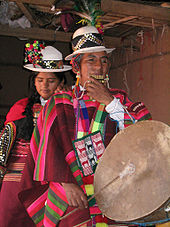
Demographics
According to the Bolivian National Statistics Institute, the censed inhabitants in 2001 were 8,274,325 from which 4,123,850 were men and 4,150,475 were women, as of 2010 the number reached 10,125,522 inhabitants.
In the last fifty years the Bolivian population has tripled; reaching a population growth rate of 2.25%. The growth of the population in the inter-census periods (1950–1976 and 1976–1992) was approximately 2.05%, while between the last period, 1992–2001, it reached 2.74% annually.
62.43% of Bolivians live in urban areas, while the remaining 37.57% in rural areas. The most part of the population (70%) is concentrated in the departments of La Paz, Santa Cruz and Cochabamba. In the Andean Altiplano region the departments of La Paz and Oruro hold the largest percentage of population, in the valley region the largest percentage is held by the departments of Cochabamba and Chuquisaca, while in the Llanos region by Santa Cruz and Beni. At national level, the population density is 8,49, with variations marked between 0,8 ( Pando Department) and 26,2 (Cochabamba Department).
The biggest concentration of population is located in the called "central axis" and in the Llanos region. Bolivia has a young population. According to the 2011 census, 59% of the population is between 15 and 59 years old, 39% is less than 15 years old. Almost 60% of the population is younger than 25 years.
| Largest cities | ||||||||||
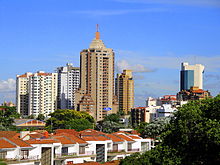 |
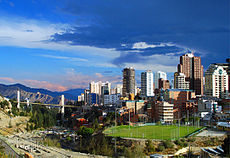 |
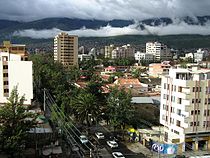 |
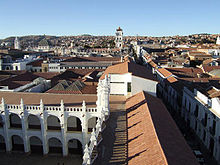 |
|||||||
|---|---|---|---|---|---|---|---|---|---|---|
| Santa Cruz de la Sierra | La Paz | Cochabamba | Sucre | |||||||
| Ten largest cities | ||||||||||
| Rank | City | Department | Population | Rank | City | Departaments | Population | |||
| 1 | Santa Cruz de la Sierra | 1,811,390 | 6 | Oruro | 235,702 | |||||
| 2 | El Alto | 1,178,349 | 7 | Tarija | 176,787 | |||||
| 3 | La Paz | 923,741 | 8 | Potosí | 150,647 | |||||
| 4 | Cochabamba | 695,226 | 9 | Sacaba | 134,518 | |||||
| 5 | Sucre | 280,225 | 10 | Montero | 95,594 | |||||
| Source: 2009 Projected population, National Statistics Institute of Bolivia (INE). | ||||||||||
Ethnicity
| Ethnic composition | |||
| Ethnic Map of Bolivia | |||
| Indigenous-Native peoples self-identification ¹ | |||
| Indigenous self-identification | 60 % | ||
| None self-identification | 40 % | ||
| Ethnic self-identification ² | |||
| Mestizo | 68 % | ||
| Indigenous | 18 % | ||
| White | 7 % | ||
| Cholo | 2 % | ||
| Afro Bolivian | 1 % | ||
| Other | 1 % | ||
| n/a | 3 % | ||
| Notes: 1 = National Census of Population and Living 2001, National Statistics Institute of Bolivia (INE). |
|||
| 2 = | |||
The ethnic composition of Bolivia includes a great diversity of cultures. Most of the indigenous peoples have assimilated a mestizo culture, diversifying and expanding their indigenous heritage. Consequently, there is in Bolivia a mix of cultures, which joins together Hispanic and Amerindian cultures.
The ethnic distribution of Bolivia is estimated to be 30% Quechua-speaking and 25% Aymara-speaking. The largest of the approximately three dozen native groups are the Quechuas (2.5 million), Aymaras (2 million), then Chiquitano (180,000), and Guaraní (125,000). So the full Amerindian population is at 55%; the remaining 30% are mestizo (mixed Amerindian and white), and around 15% are white.
- Indigenous, also called "originarios" ("native" or "original") and less frequently, Amerindians. This ethnic group is composed by the descendents of the Pre-Hispanic cultures. They can be Andean, as the Aymaras and Quechuas (which formed the ancient Inca Empire), which concentrate in the western departments of La Paz, Potosí, Oruro, Cochabamba and Chuquisaca. There also is an important oriental ethnic population, composed by the Guaraní and Moxos, among others, and that inhabit the departments of Santa Cruz, Beni, Tarija and Pando. The indigenous people compose the 60% of the Bolivian population.
- Mestizo. Ethnic mix of indigenous people and Europeans or Europeans descendents. They are distributed throughout the entire country and compose the 26% of the Bolivian population. Most people assume their mestizo identity while at the same time identifying themselves with one or more indigenous cultures.
- Whites. The most part are second-generation descendents of criollos and Europeans or Arabs, coming mostly from Germany, Croatia, Spain, Italy, Lebanon and Turkey. They are usually concentrated in the largest cities; La Paz, Santa Cruz de la Sierra and Cochabamba, but as well in some minor cities like Tarija. In the Santa Cruz Department there is an important colony (70.000 inhabitants) of German-speaking Mennonites. Whites represent 15% of the total Bolivian population.
- Afro Bolivians. Descendents of African slaves, which arrived in the times of the Spanish Empire. They inhabit the department of La Paz, and located mainly in the provinces of Nor Yungas and Sud Yungas.
- Asians. Mainly Japanese (14.000), Chinese (4.600), Koreans and Lebanese.
- Other: There are small amounts of European citizens of Germany, France, Italy and Portugal, as well as coming from other American countries, as Argentina, Brazil, Chile, Colombia, Cuba, Ecuador, United States, Paraguay, Peru, Mexico and Venezuela, among others. There are important Peruvian colonies in La Paz, El Alto and Santa Cruz de la Sierra.
Indigenous peoples
The Indigenous peoples of Bolivia are divided into two different ethnic groups; the Andeans, which are located in the Andean Altiplano and the valley region and the ethnic culture of the oriental Llanos region, which inhabit the warm regions of eastern Bolivia ( Gran Chaco).
- Andean ethnies
- Aymaras. They live on the high plateau of the departments of La Paz, Oruro and Potosí, as well as some small regions near the tropical flatlands.
- Quechuas. They inhabit mostly the valleys on Cochabamba and Chuquisaca. They also inhabit some mountain regions in Potosí and Oruro. They divide themselves into different quechua nations, as the Tarabucos, Ucumaris, Chalchas, Chaquies, Yralipes, Tirinas, among others.
- Ethnies of the Oriental Llanos
- Guaraníes. Formed by: Guarayos, Pausernas, Sirionos, Chiriguanos, Wichí, Chulipis, Taipetes, Tobas and Yuquis.
- Tacanas: Formed by: Lecos, Chimanes, Araonas and Maropas.
- Panos: Formed by: Chacobos, Caripunas, Sinabos, Capuibos and Guacanaguas.
- Aruacos: Formed by: Apolistas, Baures, Moxos, Chané, Movimas, Cayabayas, Carabecas, Paiconecas or Paucanacas.
- Chapacuras: Formed by: Itenez or More, Chapacuras, Sansinonianos, Canichanas, Itonamas, Yuracares, Guatoses and Chiquitos.
- Botocudos: Formed by: Bororos y Otuquis.
- Zamucos: Formed by: Ayoreos.
| Main Indigenous and Afro Bolivan peoples from Bolivia | ||||||||
| N° | Group | Population | % | N° | Group | Population | % | |
| 1 | Quechua | 1,558,277 | 15.54% | 6 | Afro Bolivian | 22,000 | 0.22% | |
| 2 | Aymara | 1,098,317 | 10.95% | 7 | Movima | 10,152 | 0.11% | |
| 3 | Chiquitano | 184,288 | 1.84% | 8 | Guarayo | 9,863 | 0.10% | |
| 4 | Guaraní | 133,393 | 1.33% | 9 | Chiman | 4,528 | 0.05% | |
| 5 | Moxo | 76,073 | 0.76% | 10 | Tacana | 3,056 | 0.03% | |
| Source: Wigberto Rivero Pinto (2006) | ||||||||
Language
Bolivia has a great linguistic diversity as a result of its multiculturalism. The Constitution of Bolivia recognizes 37 official languages, including besides Spanish all the languages of the native indigenous nations of Bolivia:
Considered official languages of the State are Castilian [Spanish] and all the languages of the indigenous nations and peoples, which are Aymara, Araona, Baure, Bésiro, Canichana, Cavineño, Cayubaba, Chacobo, Chiman, Ese Ejja, Guaraní, Guarasuawe, Guarayu, Itonama, Leco, Machajuyai-Kallawaya, Machineri, Maropa, Mojeño-Trinitario, Mojeño-Ignaciano, Moré, Mosetén, Movima, Pacawara, Puquina, Quechua, Sirionó, Tacana, Tapiete, Toromona, Uruchipaya, Weenhayek, Yaminawa, Yuki, Yuracaré and Zamuco.
Spanish is the most spoken official language in the country, according to the 2001 census; as it is spoken by 88.4% of the population, as a first language or second language in some indigenous populations. All legal and official documents issued by the State, including the Constitution, the main private and public institutions, the media, and commercial activities, use Spanish. It is a legal requirement that all civil servants speak at least one indigenous language.
The main indigenous languages, sorted by speaking population, are:
- Quechua (28% of the population in the 2001 census): it was the official language of the Inca Empire. It is spoken mainly in the departments of Cochabamba, Chuquisaca and Potosí.
- Aymara (18% of the population in the 2001 census): a language spoken prior the establishment of the Inca Empire. It is spoken mainly in the departments of La Paz and Oruro.
- Guarani (1% of the population in the 2001 census): spoken in the department of Santa Cruz and the region of Gran Chaco.
- Other (4% of the population in the 2001 census): minor languages, with special importance of the Moxos in the department of Beni.
English and Portuguese are also spoken by minor percentages of the population, the latter one mainly in the areas close to Brazil.
Health
In 2006, life expectancy at birth was 64 for males and 67 for females. A study by UN Development Programme and UNICEF reported that over 230 babies in Bolivia died per day through lack of proper care. The majority of the population has no health insurance. A significant part of the population has no access to healthcare. Demographic and Health Surveys has completed five surveys in Bolivia since 1989 on a wide range of topics.
Religion

Bolivia is a secular state and guarantees freedom of religion. The Constitution establishes that:
The state respects and guarantees the freedom of religion and of spiritual beliefs, in concordance with their world view. The state is independent of the religion.—Bolivian Constitution, Article 4
According to the 2001 census conducted by the Bolivian National Statistics Institute, 78% of the Bolivian population follow Roman Catholicism, while 19% follow Protestantism, and 3% have different Christian beliefs. The Protestantism along with traditional indigenous beliefs are expanding rapidly.
The number of Catholics is higher in urban areas than in rural regions, where Protestantism reaches its higher level, 20%. In the 2001 census, 2,5% stated not to have any religious affiliation and less than 0.2% stated to have different affiliations, such as Islam, Jehovah's Witnesses, Bahá'í, Judaism, Buddhism and Shintoism. There are 280 non-catholic religious organizations and more than 200 catholic groups registered by the Government.
There is an active presence of foreign missionaries, such as mennonites, lutherans, members of the Seventh-day Adventist Church, among others.
- Catholicism
The Bolivian Catholic Church has four Archdioceses, seven Dioceses, two Prelates, and five Apostolic vicariates. Among the most important Catholic events of the last decades are the visit of the Pope John Paul II in 1988 and the naming of Cardinal to the Archbishop of Santa Cruz de la Sierra Julio Terrazas.
Catholicism has been traditionally the religion with the bigger number of adherents in the country. Among the western indigenous peoples it has been part of a religious syncretism; in the last few decades however, Protestantism has become increasingly popular
The oriental indigenous cultures, such as the Chiquitanos and Moxos, remains an important cultural link with Catholicism as a product of a cultural mix inherited as a result of the Jesuit Missions.
- Indigenous beliefs
Most of the indigenous population follows different religions marked by their syncretism with the Catholic religion or complementary to it with their own world view and ancient traditions. It is important the cult to Pachamama, or "Mother Earth", as well as the adoration to the Virgin of Copacabana, Virgin of Urkupiña and Vigin of Socavón. There also are important Aymaran communities near the Lake Titicaca that have a strong devotion to James the Apostle. Other deities are the Ekeko, which is the Aymaran god of abundance and prosperity and which day is celebrated every 24 January, and Tupá, a god of the Guaraní people.
Some indigenous communities have been trying to return to their ancient customs and beliefs removing Christian influence from their belief system. In 2009, the Government through Supreme Decrete decided to recognize the celebration of the Aymaran New Year, or Wilka Kuti (return of the Sun), event that celebrates the beginning of a new solar cycle with the arrival of the winter solstice. This event is celebrated in the ruins of Tiwanaku.
- Other religions
- Latter Day Saint movement. They are present throughout the entire country. According to the LDS Church, they have more than 140,000 members.
- Jehovah's Witnesses. They are extended in the entire country. They have more than 10.000 active ministries and more than 65,000 members.
- Jew community. They are present in the entire country and have opened the first Bolivian Synagogue in La Paz.
- Mennonite. They are present in the eastern lowlands of the country in the Department of Santa Cruz 100,000+ Mennonites.
- Muslim community. They have four cultural centres that also work as mosques in La Paz, Santa Cruz de la Sierra and Cochabamba.
- No religion. Around 3% of the population identify themselves either agnostic or atheist.
Politics and government

Bolivia has been governed by democratically elected governments since 1982, when a long string of military coups came to an end. Presidents Hernán Siles Zuazo (1982–85) and Víctor Paz Estenssoro (1985–89) began a tradition of ceding power peacefully which has continued, although two presidents have stepped down in the face of popular protests: Gonzalo Sánchez de Lozada in 2003 and Carlos Mesa in 2005. Bolivia's multiparty democracy has seen a wide variety of parties in the presidency and parliament, although the Revolutionary Nationalist Movement, National Democratic Action, and the Revolutionary Left Movement predominated from 1985 to 2005. The current president is Evo Morales, the first indigenous Bolivian to serve as head of state. Morales' Movement for Socialism – Political Instrument for the Sovereignty of the Peoples party was the first to win an outright presidential majority in four decades, doing so both in 2005 and 2009.
The constitution, drafted in 2006–07 and approved in 2009, provides for balanced executive, legislative, judicial, and electoral powers, as well as several levels of autonomy. The traditionally strong executive branch tends to overshadow the Congress, whose role is generally limited to debating and approving legislation initiated by the executive. The judiciary, consisting of the Supreme Court and departmental and lower courts, has long been riddled with corruption and inefficiency. Through revisions to the constitution in 1994, and subsequent laws, the government has initiated potentially far-reaching reforms in the judicial system as well as increasing decentralizing powers to departments, municipalities, and indigenous territories.
Capital
Bolivia has its constitutionally recognized capital in Sucre, while La Paz is the seat of government. La Plata (now Sucre) was proclaimed provisional capital of the newly independent Alto Peru (later, Bolivia) on 1 July 1826. On 12 July 1839, President José Miguel de Velasco proclaimed a law naming the city as the capital of Bolivia, and renaming it in honour of the revolutionary leader Antonio José de Sucre. The Bolivian seat of government moved to La Paz at the turn of the twentieth century, as a consequence of Sucre's relative remoteness from economic activity after the decline of Potosí and its silver industry and of the Liberal Party in the War of 1899.
The 2009 Constitution assigns the role of national capital to Sucre, not referring to La Paz in the text. In addition to being the constitutional capital, the Supreme Court of Bolivia is located in Sucre, making it the judicial capital. Nonetheless, the Palacio Quemado (the Presidential Palace and seat of Bolivian executive power) is located in La Paz, as are the National Congress and Plurinational Electoral Organ. La Paz thus continues to be the seat of government.
Executive branch
The executive branch is headed by a President and Vice President, and consists of a variable number (currently, 20) of government ministries. The president is elected to a five-year term by popular vote, and governs from the Presidential Palace (popularly called the Burnt Palace, Palacio Quemado) in La Paz. In the case that no candidate receives an absolute majority of the popular vote or more than 40% of the vote with an advantage of more than 10% over the second place finisher, a run-off is to be held among the two candidates most voted.
Prisons
There are 53 prisons in Bolivia which incarcerate around 8,700 people as of 2010. The prisons are managed by the Penitentiary Regime Directorate (Spanish: Dirección de Régimen Penintenciario). There are 17 prisons in departmental capital cities and 36 provincial prisons.
Legislative branch
The Asamblea Legislativa Plurinacional ( Plurinational Legislative Assembly or National Congress) has two chambers. The Cámara de Diputados (Chamber of Deputies) has 130 members elected to five-year terms, seventy from single-member districts (circunscripciones), sixty by proportional representation, and seven by the minority indigenous peoples of seven departments. The Cámara de Senadores (Chamber of Senators) has 36 members (four per department). Members of the Assembly are elected to five-year terms. The body has its headquarters on the Plaza Murillo in La Paz, but also holds honorary sessions elsewhere in Bolivia. The Vice President serves as titular head of the combined Assembly.
Judicial branch

The judiciary consists of the Supreme Court, the Constitutional Tribunal, the Judiciary Council, Agrarian and Environmental Tribunal, and District (departmental) and lower courts.
- Plurinational Constitutional Tribunal (Spanish: Tribunal Constitucional Plurinacional) — rules on the constitutionality of government or court actions
- Supreme Court or Supreme Tribunal of Justice (Spanish: Tribunal Supremo de Justicia)
- Agrarian and Environmental Tribunal (Spanish: Tribunal Agroambiental) — highest court authority in matters of agriculture and the environment
- Judiciary Council (Spanish: Consejo de la Magistratura) — oversees the conduct of courts and judges, including misconduct and ethical violations
- District Courts (one in each department)
- Provincial and local courts
In October 2011, Bolivia held its first judicial elections to choose members of the national courts by popular vote, a reform brought about by Evo Morales.
Electoral branch
The electoral branch of Bolivia's government, formally the Plurinational Electoral Organ, is an independent branch of government which replaced the National Electoral Court in 2010. The branch consists of the Supreme Electoral Tribunal, the nine Departmental Electoral Tribunals, Electoral Judges, the anonymously selected Juries at Election Tables, and Electoral Notaries. Wilfredo Ovando presides over the seven-member Supreme Electoral Tribunal. Its operations are mandated by the Constitution and regulated by the Electoral Regime Law (Law 026, passed 2010). The Organ's first elections were the country's first judicial election in October 2011, and five municipal special elections held in 2011.
Military
The Bolivian military comprises three branches: Ejército (Army), Naval (Navy) and Fuerza Aérea (Air Force). The legal age for voluntary admissions is 18; however, when the numbers are small the government recruits anyone as young as 14. The tour of duty is generally 12 months. The Bolivian government annually spends $130 million on defense.
The Bolivian Army has around 31,500 men. There are six military regions (regiones militares—RMs) in the army. The Army is organized into ten divisions.
Though it is landlocked Bolivia keeps a navy. The Bolivian Naval Force (Fuerza Naval Boliviana in Spanish) is a naval force about 5,000 strong in 2008.
The Bolivian Air Force ('Fuerza Aérea Boliviana' or 'FAB') has nine air bases, located at La Paz, Cochabamba, Santa Cruz, Puerto Suárez, Tarija, Villamontes, Cobija, Riberalta, and Roboré.
Civil aviation
The General Directorate of Civil Aeronautics (Dirección General de Aeronáutica Civil—DGAC) formerly part of the FAB, administers a civil aeronautics school called the National Institute of Civil Aeronautics (Instituto Nacional de Aeronáutica Civil—INAC), and two commercial air transport services TAM and TAB.
TAM (Transporte Aéreo Militar)
TAM – Transporte Aéreo Militar (the Bolivian Military Airline) is an airline based in La Paz, Bolivia. It is the civilian wing of the 'Fuerza Aérea Boliviana' (the Bolivian Air Force), operating passenger services to remote towns and communities in the North and Northeast of Bolivia. TAM (a.k.a. TAM Group 71) has been a part of the FAB since 1945.
A similar airline serving the Beni Department with small planes is Línea Aérea Amaszonas, using smaller planes than TAM.
TAB (Transportes Aéreos Bolivianos)
Although a civil transport airline, TAB – Transportes Aéreos Bolivianos, was created as a subsidiary company of the FAB in 1977. It is subordinate to the Air Transport Management (Gerencia de Transportes Aéreos) and is headed by an FAB general. TAB, a charter heavy cargo airline, links Bolivia with most countries of the Western Hemisphere; its inventory included a fleet of Hercules C130 aircraft. TAB was headquartered adjacent to El Alto International Airport. TAB also flew to Miami and Houston, with stops in Panama.
Culture
Bolivian culture has been heavily influenced by the Quechua, the Aymara, as well as by the popular cultures of Latin America as a whole.
The cultural development is divided into three distinct periods: precolumbian, colonial, and republican. Important archaeological ruins, gold and silver ornaments, stone monuments, ceramics, and weavings remain from several important pre-Columbian cultures. Major ruins include Tiwanaku, El Fuerte de Samaipata, Incallajta, and Iskanawaya. The country abounds in other sites that are difficult to reach and have seen little archaeological exploration.
The Spanish brought their own tradition of religious art which, in the hands of local native and mestizo builders and artisans, developed into a rich and distinctive style of architecture, painting, and sculpture known as "Mestizo Baroque". The colonial period produced not only the paintings of Pérez de Holguín, Flores, Bitti, and others but also the works of skilled but unknown stonecutters, woodcarvers, goldsmiths, and silversmiths. An important body of Native Baroque religious music of the colonial period was recovered and has been performed internationally to wide acclaim since 1994.
Bolivian artists of stature in the 20th century include Guzmán de Rojas, Arturo Borda, María Luisa Pacheco, Roberto Mamani Mamani, Alejandro Mario Yllanes, Alfredo Da Silva, and Marina Núñez del Prado.
Bolivia has a rich folklore. Its regional folk music is distinctive and varied. The "devil dances" at the annual carnival of Oruro are one of the great folkloric events of South America, as is the lesser known carnival at Tarabuco. The best known of the various festivals found in the country is the " Carnaval de Oruro", which was among the first 19 "Masterpieces of the Oral and Intangible Heritage of Humanity", as proclaimed by the UNESCO in May 2001.
Entertainment includes football, which is the most popular sport, as well as table football, which is played on street corners by both children and adults.
Education
Under UNESCO standards, Bolivia has been declared free of illiteracy in 2008, making it the fourth country in Latin America with this status.
Bolivia has a wide variety of public and private universities. Among them: Universidad San Francisco Xavier de Chuquisaca USFX – Sucre, founded in 1624; Universidad Mayor de San Andres UMSA – La Paz, founded in 1830; Universidad Mayor de San Simon UMSS – Cochabamba, founded in 1832; Universidad Autónoma Gabriel René Moreno UAGRM – Santa Cruz de la Sierra, founded in 1880; Universidad Tecnica de Oruro UTO – Oruro, founded in 1892; Universidad Autónoma Tomás Frías UATF – Potosi, founded in 1892; Universidad Juan Misael Saracho UJMS – Tarija, founded in 1946; Universidad Católica Boliviana San Pablo UCB, founded in 1966; Universidad Técnica del Beni UTB – Trinidad, founded in 1967; Universidad Nur NUR, founded in 1982; Universidad Privada de Santa Cruz de la Sierra UPSA – Santa Cruz de la Sierra, founded in 1984; Universidad Nacional Siglo XX UNSXX – Llallagua, founded in 1986; Universidad del Valle UNIVALLE -Cochabamba, founded in 1988; Universidad Privada Boliviana UPB, founded in 1993; Universidad Privada Franz Tamayo UPFT, founded in 1993 and Universidad Amazónica de Pando UAP – Cobija, founded in 1993.
For the first time in Bolivian history, three indigenous universities were created: Universidad Aymara Tupac Katari UATK – La Paz, founded in 2009; Universidad Quechua Casmiro Huanca UQCH – Cochabamba, founded in 2009 and Universidad Boliviana Guaraní y Pueblos de Tierras Bajas UGPTB – Chuquisaca, founded in 2009.




